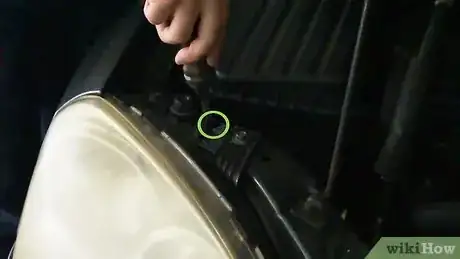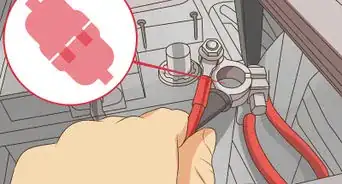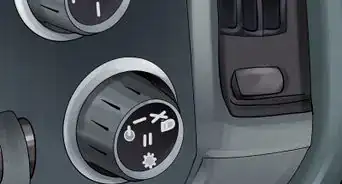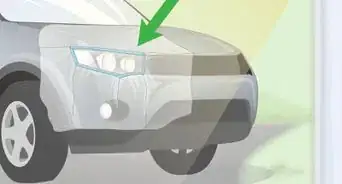This article was co-authored by Rocco Lovetere and by wikiHow staff writer, Eric McClure. Rocco Lovetere is the Owner and a Master Mechanic at Rocco's Mobile Auto Repair in California. With over 20 years of experience, he specializes in Honda, Acura, Toyota, Nissan, Infiniti, and Volvo cars. He is an ASE Certified Automotive technician and has worked in automotive repair since 1999.
wikiHow marks an article as reader-approved once it receives enough positive feedback. In this case, several readers have written to tell us that this article was helpful to them, earning it our reader-approved status.
This article has been viewed 1,277,776 times.
If you’ve been in a crash or you swapped out your headlight bulbs, you might end up with misaligned headlights that need adjusting. Misaligned headlights are dangerous, so it’s good you’re taking the steps to fix this. If your headlights are too high, you’ll blind other drivers, while if they’re too low you may not spot pedestrians and other cars in time to avoid collisions. Luckily, this is a lot easier than you might think. So long as you’ve got 25 feet (7.6 m) of space to work, a vertical wall, some tape, and a screwdriver, you’re good to go! Read on to learn how to fix the angle of your headlights.
Things You Should Know
- Park your car in front of a flat wall and mark the center points of each light on the wall with tape.
- Pull back 25 feet (7.6 m) to see how your lights relate to the center point of each + sign on the wall.
- Pop the hood and look for adjustment screws on top of each bulb. Adjust these screws as needed until your headlights are correct.
- The lights are correct when the area below the horizontal line is illuminated and the bright spots are centered on the middle of each +.
Steps
Setting Up
-
1Make adjustments to get your vehicle to its average weight and height. Start by removing any excess weight you normally don’t carry from the trunk of the car. Also, check your tire pressure to ensure it’s at the manufacturer's recommended levels. If possible, have somebody sit in the driver's seat while you do this and aim for a day when your gas tank is half full.[1]
-
2Park your car on level ground, facing a perfectly vertical wall. You can do this in an indoor garage or at your home if you’ve got a large garage and it’s dark out. Use a spirit level to confirm the wall is more or less flat. Park as close as you can to the wall while still leaving room.[2]Advertisement
-
3Level the shocks by pushing the corners of the car down. This jolts the suspension and forces the car to level out. Just go to each corner of the vehicle and firmly push down on the body to make your vehicle pop up and down a few inches.
- Sometimes, when you drive and park your vehicle, the momentum compresses the shocks on one side of your car. You want the lights to be as ideally placed as possible!
- Alternatively, you can measure the distance to the ground from both headlights to ensure that the suspension itself is level.
Making Your Alignment Grid
-
1Turn the headlights on and mark the centers on the wall. Do not use your high beams or fog lights. Locate the brightest point of light on the wall for each bulb. Use masking or painter’s tape to put two + signs on the wall. Use a spirit level to ensure the horizontal and vertical lines are perfectly straight.[3]
- You can also measure the distance from the floor to each bulb and then mark those measurements on the wall if you want to be extremely scientific.
-
2Use a spirit level to see if the + signs are on the same horizontal plane. Place a spirit level between the two marked center lines to see if they are even. If they are not even, use a tape measure to measure how far up the wall the lower mark is and lower the other center line marker to the same height. These center lines should be no higher than 3.5 feet (1.1 m) from the ground.[4]
- If your two lights aren’t even, measure the distance from the ground to your bulb. Then, transfer that measurement to the wall to figure out which + sign is too high or too low. Redo that + sign.
-
3Back your car exactly 25 ft (7.6 m) from the wall. Don't estimate the distance! Use a tape measure to make sure you are the proper distance away from the wall. This is the distance your headlights should normally extend to.[5]
- Always defer to the specs in the owner's manual—some manufacturers recommend different distances for proper adjustment, although 25 feet (7.6 m) is the most common distance.
Adjusting the Lights
-
1Turn the headlights on and assess where the light sits on the wall. Those two + signs you put on the wall aren’t just for show. The brightest point should be the center of each +, and only the area below the middle horizontal lines should be illuminated.[6]
- If the brightest points aren’t the center of each +, you need to adjust your lights horizontally.
- If the area above the horizontal line on each + is illuminated, you need to lower the lights. If the light is super low, they need to be raised.
- If your lights are too high, they can blind other drivers. If they’re too low, you won’t be able to see pedestrians and other cars in time to prevent accidents.
-
2Locate the adjusting screws on the housing for each light. The exact location of each screw will differ from make and model to make and model, although every model works basically the same way—one screw is for up/down adjustments and the other screw is for left/right. You use a screwdriver to manually adjust the angle of the bulb.[7]
- You usually have to pop the hood to access the bolts on the inside of the engine bay. In some vehicles, you just pop a flange off the rim of the light to expose the screws on the outside.
- Some cars may feature adjustment bolts rather than screws.
- On Hondas specifically, there is a bubble level on each headlight casing to help you confirm your lights are correct.
- You shouldn’t have to remove the light, but you may need to remove a coolant tank, cover, or panel to access the headlight casing. Refer to your manual for more info.
-
3Block one headlight so you can focus on adjusting the other. Put a sheet of cardboard or a chair with a coat on the back in front of one light while you adjust the other. This way, the light from the other light won’t bleed into the headlight you’re adjusting.[8]
- If you have a have a helper to sit in the driver's seat while you do the adjustments, now is the time to ask them to hop in the vehicle.
-
4Turn the upper screw or bolt to adjust the vertical field. Clockwise usually raises the lights, while counterclockwise turns should lower them. Use a screwdriver and some good old-fashioned trial and error to change the height of the light. Move the bulb until the area directly below the horizontal line on your + sign is illuminated. [9]
- The top of the most intense part of the beam should be even with, or just below the center of the line of tape you made. This way, you can see ahead while you drive without blinding other drivers.
-
5Adjust the other set of screws or bolts to make horizontal adjustments. Use the same screwdriver to make adjustments to the second screw, if necessary. Move the headlights horizontally until the most intense portion of the headlight beam is hitting the vertical bar on the + sign on the wall.[10]
-
6Test your alignment by driving the vehicle on a safe, quiet road. Since you aren’t sure the lights are perfect just yet, drive slow on a street that won’t have any pedestrians or traffic (an alley is ideal). Make any additional adjustments by repeating the process again until your lights are correct.[11]
- If your lights “feel” off, they probably are. You should be able to see slightly beyond 25 feet (7.6 m), which is 3-4 car lengths.
- Do this at night! You aren’t going to be able to see whether your lights are correct or not during the day.
Warnings
- Take your car to a mechanic to have the headlights adjusted if you are unable to do so, especially if you know your headlights need to be adjusted.⧼thumbs_response⧽
Things You'll Need
- Phillips screwdriver or socket
- Masking tape
- Tape measure
- Spirit level
References
- ↑ https://www.popularmechanics.com/cars/a257/how-to-adjust-lights/
- ↑ https://carorbis.com/blog/how-to-adjust-a-car-headlight/
- ↑ https://www.jwspeaker.com/wp-content/uploads/headlight-aiming-instructions-low-or-low-and-high-beam-2016.pdf
- ↑ https://www.jwspeaker.com/wp-content/uploads/headlight-aiming-instructions-low-or-low-and-high-beam-2016.pdf
- ↑ https://www.jwspeaker.com/wp-content/uploads/headlight-aiming-instructions-low-or-low-and-high-beam-2016.pdf
- ↑ https://www.spyderusa.com/spy/images/pdf/lighting/HAS.pdf
- ↑ https://carorbis.com/blog/how-to-adjust-a-car-headlight/
- ↑ https://carorbis.com/blog/how-to-adjust-a-car-headlight/
- ↑ https://static.nhtsa.gov/odi/tsbs/2021/MC-10202201-0001.pdf
About This Article
To adjust your car headlights, first park your car on flat ground facing a bare wall. Unload anything heavy and make sure the pressure in all 4 tires is correct so your car is level. Then, pull up as close to the bare wall as possible and turn on the low-beam headlights. Mark where the lights hit the wall by running pieces of tape vertically and horizontally through the center of each low beam. Next, back your car up so it’s 25 feet (7 ½ meters) away from the wall. Some vehicles will require a greater or lesser distance, so make sure you refer to your car’s instruction manual. Block one of the headlights and look to see where the other beam hits the wall. It should fall at or below the horizontal tape line you marked and to the right of the vertical tape line. If it doesn’t, use the adjusters located on the headlight housing to adjust the beam until it hits the right spot on the wall. Finally, repeat with the other headlight. Always refer to your car’s instruction manual since exact headlight aiming requirements are different for every vehicle. For more tips from our Mechanic co-author, like how to tell if your car is level before you get started, read on!










-Step-27.webp)



















































